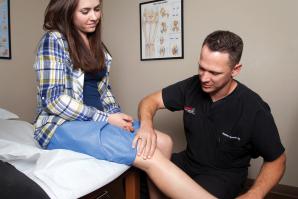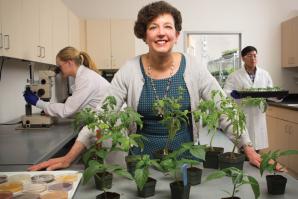A broken leg used to be a death sentence for a horse. Now, the University of California veterinary teaching hospital in Davis is using stem cells to help the horses heal quickly. The university also is developing “disease teams” at the medical school to use stem cells on the liver, blood vessels and bones. These medical advancements may also help heal the regional economy.
UC Davis just landed a $20 million grant to finish preclinical stem cell studies related to Huntington’s disease, and that single grant means jobs at the med school, plus orders for companies that supply stem cells and equipment. Some of those are located in the Capital Region as well. If the studies lead to a successful treatment, it could result in demand for more lab space, tech and nontech jobs, even hotel rooms and restaurants. For a local economy that has missed out on much of California’s recovery from the recession, it’s a prospect with a lot of potential.
“Think of the shot in the arm for the Sacramento economy,” says Fred Meyers, executive associate dean of the UC Davis Medical School.
Stem cells, or regenerative medicine, have already brought millions of dollars to the region for research and have generated a growing number of jobs in the private sector. Stem cells can turn themselves into any other kind of cell in the body, and commercialization of the technology could take any number of paths.
The big economic driver of stem cell research all across California so far has been the California Institute for Regenerative Medicine, which was created by the passage of Proposition 71 in 2004. Based in San Francisco, CIRM has given out $1.75 billion in funding in the past seven years.
Three dozen of those awards have gone to UC Davis, for a total of about $131 million, though universities and private companies elsewhere in the state have grabbed much larger shares. More than a dozen Bay Area organizations get CIRM grants; Los Angeles and San Diego areas have similar clusters.
But while most CIRM grants are for basic research, UC Davis has a more commercial focus, Meyers says. Its goal is to make a more immediate economic impact by turning the research into marketable products quickly. In addition to its worth with Huntington’s disease, the campus has other disease teams working on ways to use stem cells to treat hearing loss, burns, blood disorders, eye degeneration and diseases in various organs.
Part of UC Davis’s regenerative medicine program is the Good Manufacturing Practices Facility, where clinical-grade stem cells are developed for other universities across the country. Those contracts already have brought in about $4 million, Meyers says. Regenerative medicine is responsible for about 330 jobs on campus.
“Then we also have some increasing numbers of partners in industry working in the area,” Meyers says. They include Petnet Solutions, a subsidiary of Siemens that has space in the UC Davis stem cell building.
CIRM has faced criticism that its 29-member governing board, the Independent Citizens’ Oversight Committee, is largely composed of people representing the same organizations vying for grant money. That includes Dr. Claire Pomeroy, who stepped down last year as dean of the UC Davis School of Medicine.
But CIRM also has trouble avoiding conflict-of-interest charges because Proposition 71 required the board to be drawn primarily from research centers, biotech companies and patient advocates, and there aren’t enough to go around, say board representatives.
CIRM did, however, institute new rules early this year that no board member who also belongs to an institution that receives or could receive funds from the stem cell agency is eligible to vote on any funding issues. They still will be allowed to discuss those issues unless it involves their institution.
Thirteen institutions get about 90 percent of CIRM funding, but these same institutions also get around 90 percent of California’s funding from the National Institutes of Health. “They are not only the biggest research organizations in the state, they are also among the best in the country. It would be a surprise if they didn’t get the biggest share of funding,” said CIRM spokesman Kevin McCormack.
The Jackson Laboratory, a nonprofit genetics research organization based in Maine, also landed a $3.8 million CIRM grant for its Sacramento laboratory.
Jackson raises and develops lab mice for research practices. The CIRM grant is to prepare lab mice specifically for testing stem cell therapies.
Other entrepreneurs have managed to get businesses going without direct CIRM funding. SynGen Inc., for instance, makes lab equipment that extracts stem cells from umbilical cord blood, bone marrow and other sources. The Sacramento company landed $5 million in venture funding last year.
StemExpress in Placerville is a 21-employee company that supplies stem cells, blood, tissue samples and similar specimens to researchers. Only three years old, it is on target to hit $3 million in revenue this year. The company separates stem cells from tumors, umbilical cords and fat tissue. About 75 percent of its clients are academic institutions across the country, plus private sector clients such as Genentech, ThermoGenesis and Roche.
CEO Cate Dyer got her inspiration while working in patient care. She noticed that when an organ donor died and the organs were taken for transplant, there was no mechanism to use the rest of the body for medical research.
“I really became passionate about trying to fix that,” she says. She knew a researcher at Johns Hopkins University who volunteered to be her first customer.
But why Placerville, when the hotbed of regional biotech is in the Bay Area? Originally it was because Dyer lives there and didn’t want to move. But she also found a level of support she doesn’t think she’d get elsewhere.
El Dorado County Supervisors offered StemExpress a financial incentive to provide special training to run-of-the-mill lab techs, and the county also offered to help the company find larger quarters if needed.
“When I talk to my friends in Berkeley, Oakland and Alameda with really established companies, the county won’t do anything for them,” she says. “Up here, El Dorado County has money set aside to help these science-related fields.”
She also credits the Next Economy project and the Sacramento Area Regional Technology Alliance, which has helped her network. Additionally, when Dyer was struggling to land a small-business loan, SARTA connected her with Five Star Bank where she was able to borrow $500,000.
Finding qualified employees hasn’t been a problem. More than half live right in El Dorado County. When Dyer spoke at an event at the Shriners Hospital in Sacramento, she found a lot of people interested in applying for jobs. She also set up an internship with California State University Sacramento, which offers a master’s degree program with a concentration in stem cells.
The two-year program, funded through a CIRM grant and run in collaboration with UC Davis, has room for 10 students a year. The program is now in its fourth year.
Many of them end up in the lab where they have trained, says Tom Peavy, graduate adviser in the Department of Biological Sciences. Some continue on the doctoral programs, some go on to medical school, “but most of them stay more local rather than not,” he says.
“I think what is really brewing underneath the surface is getting some success stories for stem cell research,” he adds. “There is a lot of promise there, and it just needs some fruition for people to point to.”
Recommended For You

Avoiding the Pop
Why do so many women tear their ACL, and how can they prevent it?
In one of the crueler twists of sports, ACL tears often happen in freak accidents that you can’t really control. Seventy percent occur without contact. Even more cruelly, a woman is four times more likely than a man to tear the ligament — especially if she’s young and active.




